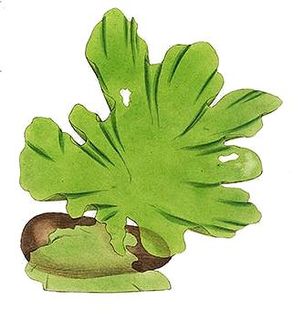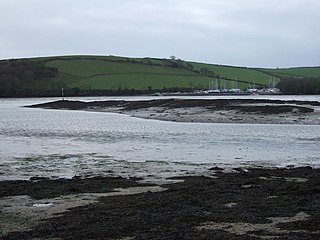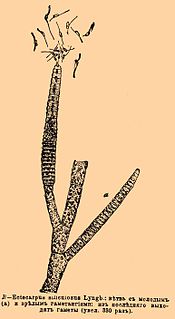| Gymnothamnion | |
|---|---|
| Scientific classification | |
| (unranked): | Archaeplastida |
| Division: | Rhodophyta |
| Class: | Florideophyceae |
| Order: | Ceramiales |
| Family: | Wrangeliaceae |
| Genus: | Gymnothamnion J.Agardh |
Gymnothamnion is a red alga genus in the family Wrangeliaceae.
| Gymnothamnion | |
|---|---|
| Scientific classification | |
| (unranked): | Archaeplastida |
| Division: | Rhodophyta |
| Class: | Florideophyceae |
| Order: | Ceramiales |
| Family: | Wrangeliaceae |
| Genus: | Gymnothamnion J.Agardh |
Gymnothamnion is a red alga genus in the family Wrangeliaceae.

The sea lettuces comprise the genus Ulva, a group of edible green algae that is widely distributed along the coasts of the world's oceans. The type species within the genus Ulva is Ulva lactuca, lactuca being Latin for "lettuce". The genus also includes the species previously classified under the genus Enteromorpha, the former members of which are known under the common name green nori.
Cystophora is a genus of brown algae.

Cystoseira is a genus of brown algae in the order Fucales.
The APG III system of flowering plant classification is the third version of a modern, mostly molecular-based, system of plant taxonomy being developed by the Angiosperm Phylogeny Group (APG). Published in 2009, it was superseded in 2016 by a further revision, the APG IV system.

Rhodomelaceae is estimated to be the largest red algae family, with about 125 genera and over 700 species.

Nitella is a genus of charophyte green algae in the family Characeae.
Bangia is an extant genus of division Rhodophyta that grows in marine or freshwater habitats. Bangia has small thalli with rapid growth and high reproductive output, and exhibits behavior characteristic of r-selected species. The plants are attached by down-growing rhizoids, usually in dense purple-black to rust-colored clumps. The chloroplasts of Bangia, like others in the division Rhodophyta, contain chlorophyll a and sometimes chlorophyll d, as well as accessory pigments such as phycobilin pigments and xanthophylls. Depending on the relative proportions of these pigments and the light conditions, the overall color of the plant can range from green to red to purple to grey; however, the red pigment, phycoerythrin, is usually dominant.
G. elegans may refer to:
Martensia is a genus of red algae, containing the following species:

Chondria is a red alga genus in the family Rhodomelaceae.

Gymnothamnion elegans is a red alga species in the genus Gymnothamnion found in South Africa from Bakoven on Cape Peninsula to KwaZulu-Natal.

Ectocarpus is a genus of filamentous brown alga that is a model organism for the genomics of multicellularity. Among possible model organisms in the brown algae, Ectocarpus was selected for the relatively small size of its mature thallus and the speed with which it completes its life cycle. The type species for the genus is Ectocarpus siliculosus (Dillwyn) Lyngbye. The life history is an isomorphic to slightly heteromorphic alternation of generations, but asexual strains also exist.

Rivularia is a genus of cyanobacteria of the family Rivulariaceae.
The APG IV system of flowering plant classification is the fourth version of a modern, mostly molecular-based, system of plant taxonomy for flowering plants (angiosperms) being developed by the Angiosperm Phylogeny Group (APG). It was published in 2016, seven years after its predecessor the APG III system was published in 2009, and 18 years after the first APG system was published in 1998. In 2009, a linear arrangement of the system was published separately; the APG IV paper includes such an arrangement, cross-referenced to the 2009 one.

Griffithsia is a genus of red algae in the family Wrangeliaceae.